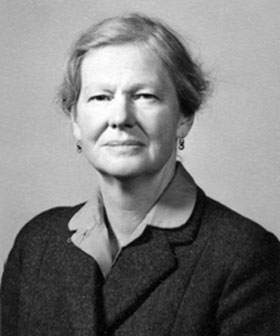Nancy K Sandars
BIOGRAPHY – 1960s and Later Life
Nancy Sandars continued her series of journeys in Europe and the Middle East, researching archaeology and art.
During the 1960s, 1970s and 1980s, she published a number of books that became authoritative works on prehistoric art and civilisation, including her interpretation of 'The Epic of Gilgamesh', one of the earliest discovered literarary works. There existed scholarly translations of the ancient text, but they were not easy to read. Nancy's new work made the story accessible to a general readership as part of the Penguin Classics series. She also wrote 'The Sea-Peoples: warriors of the ancient Mediterranean' (see below).
Nancy corresponded frequently and travelled abroad with Stuart Piggott, one of the leading 20th Century archaeologists who developed prehistoric archaeology as a discipline in Britain, along with Christopher Hawkes, with whom Nancy studied at Oxford.
Eastern Europe travel in 1960
In 1960 she went to Eastern Europe to meet archaeologists and discuss their finds. Her travels took her into Hungary, Romania and Bulgaria - normally inaccessible Communist countries.
NKS: I went with Stuart Piggott, Terence Powell and John Cowen. My archaeological research was funded by a grant from St Hugh's College Oxford, on an Elizabeth Wordsworth studentship. Stuart Piggott was Abercrombie Professor of Archaeology at Edinburgh. He had already brought out Neolithic Cultures of the British Isles and was carrying out further research on the European Neolithic. Terence Powell was Senior Lecturer in Archaeology at Liverpool University and a close friend of Stuart Piggott. John Cowen was an amateur archaeologist, engaged on a special study on swords. He was a senior executive of Barclays Bank.
We knew little of the recent archaeological work beyond the Iron Curtain, but there were rumours of spectacular finds. We had little except a few names. Communism reigned and the rule was that the head man of the museum was a communist and his assistants would be archaeologists. Before leaving London about April 15th we had a briefing from the Foreign Office who said they would like to see us when we returned. We left by train for Hungary and Rumania and Bulgaria about Monday 18th on long distance trains, German Austrian and Polish.
Other notable trips
- In 1962 she returned to Turkey where she joined Rachel Maxwell-Hyslop, a lecturer in archaeology at London University. Rachel became a close friend and later a near neighbour in Little Tew.
- In 1966 Nancy travelled to Persia (Iran), Georgia and Armenia.
- In 1967 she visited Jerusalem at Easter, returning via Athens.
Written works
Nancy has published a number of books on ancient people and their culture. A notable publication in 1978 was The Sea-Peoples: warriors of the ancient Mediterranean (editions: Thames & Hudson 1980, revised 1985).
NKS (about the Sea Peoples): Some time towards the end of the second millennium BC, the great powers of Egypt and the Hittites were devastated by enemies from the north, who came by land or sea. They attacked Egypt and are illustrated in Egyptian monuments. They destroyed the Hittite capital and the Mycenaens in Crete and sites in Palestine. They were known as the Sea Peoples. The search for their origin was the subject of my book. From the confusion of these years came the establishment of the alphabet and people speaking Indo-European languages in Palestine and Greece; the Assyrian empire followed by the Persians; also scyths and people of Turkish and Mongolian race. This was the reason for my later travels in the Near East.

Nancy in the 1960s
Related links
Letters sent home to her sister Betty Sandars while travelling:
» Letters from 1960 trip to Eastern Europe
» Letters from 1966 trip to Persia